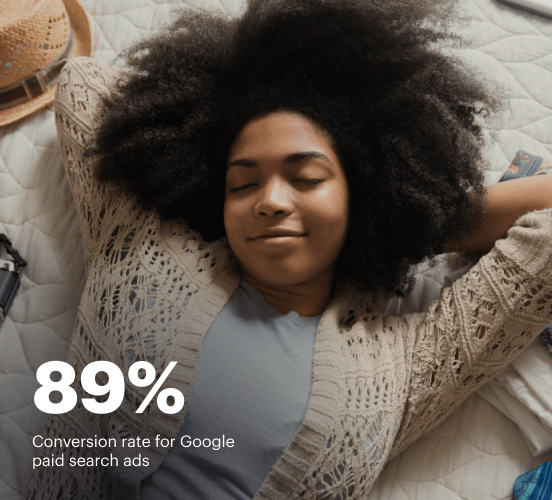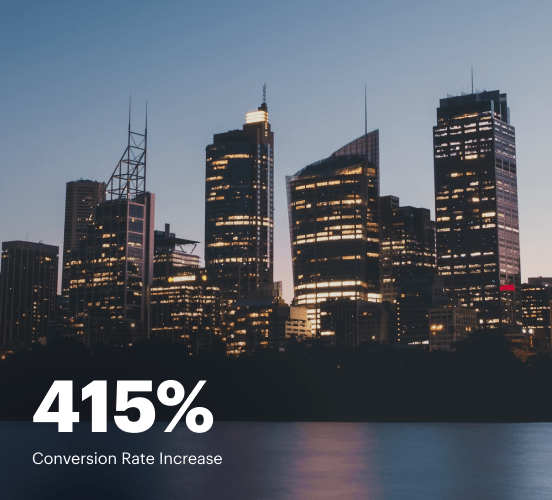Microsoft Forms vs. Typeform: the best platform for a seamless web experience
Discover how Microsoft Forms compares to Typeform regarding features and usability. Find out which platform provides the competitive advantage your business deserves.
Get startedSee how Instapage stacks up against the competition
| Feature | Instapage | Other builders |
| Drag-and-Drop Tools | ||
| Conversion-optimized templates | ||
| Manual and AI-powered A/B Tests | ||
| AI content suggestions | ||
| Popups and sticky bars | ||
| Canvas and grid blocks | ||
| Reusable and global elements | ||
| Form and popup builders | ||
| Built-in Heatmaps | ||
| Central analytics dashboard | ||
| Ad-to-page personalization and collections | ||
| Contacts, lists, and email | ||
| Dedicated, full-service CRO experts | ||
| Enterprise-ready platform |
Leading the way in building high-performing landing pages





Why Instapage is the smarter choice for your campaigns
Get everything you need to build, scale, and optimize high-converting landing pages—without coding.

Easier page building without coding
Instapage offers a flexible and seamless page creation experience with a library of 500+ conversion-focused layouts, Instablocks®, a drag-and-drop builder, and AI content generation. With technologies like Thor Render Engine®, you can create on-brand, mobile-responsive landing pages that load quickly and start converting during initial visitor clicks.

More insights — better results
Instapage lets you see in detail how each landing page experience and variation is performing so you can make targeted changes that boost page conversions. Use heatmaps for a better understanding of on-page activities, run A/B tests and AI-assisted experiments, and then track and evaluate results within robust analytics dashboards.

More personalized experiences
Instapage lets you quickly create high-performing landing pages tailored to each of your ad campaigns. Deliver personalized experiences for distinct audiences using dynamic text replacement. Effortlessly align specific advertisements to unique pages with AdMaps. Monitor audience-level metrics using our advanced data tools.

Built-in collaboration
Instapage collaboration capabilities bring your entire team together to speed up the process of landing page review, approval, and launch. No more frustrating and unnecessary revisions or edits scattered across emails. Provide instant feedback, conduct real-time page edits, and securely share your pages with outside stakeholders.

Free up time for your business
Invest time into business growth, not busy work. Launch landing pages faster with reusable forms and templates. Build once, reuse forever.
Explore all integrations






Easier page building without coding
Instapage offers a flexible and seamless page creation experience with a library of 500+ conversion-focused layouts, Instablocks®, a drag-and-drop builder, and AI content generation. With technologies like Thor Render Engine®, you can create on-brand, mobile-responsive landing pages that load quickly and start converting during initial visitor clicks.
More insights — better results
Instapage lets you see in detail how each landing page experience and variation is performing so you can make targeted changes that boost page conversions. Use heatmaps for a better understanding of on-page activities, run A/B tests and AI-assisted experiments, and then track and evaluate results within robust analytics dashboards.
More personalized experiences
Instapage lets you quickly create high-performing landing pages tailored to each of your ad campaigns. Deliver personalized experiences for distinct audiences using dynamic text replacement. Effortlessly align specific advertisements to unique pages with AdMaps. Monitor audience-level metrics using our advanced data tools.
Built-in collaboration
Instapage collaboration capabilities bring your entire team together to speed up the process of landing page review, approval, and launch. No more frustrating and unnecessary revisions or edits scattered across emails. Provide instant feedback, conduct real-time page edits, and securely share your pages with outside stakeholders.
Free up time for your business
Invest time into business growth, not busy work. Launch landing pages faster with reusable forms and templates. Build once, reuse forever.
Explore all integrationsGet started with Instapage in a few steps
-
Create your Instapage account
Start with Instapage by signing up via Google or your email. You'll get access to a free 14-day trial to discover Instapage capabilities. Feel free to cancel anytime during the 14-day trial if you decide that our product is not suitable for your business. -
Build and personalize your page
Create your first landing page from scratch or choose a template from 500+ customizable layouts. Use the drag-and-drop builder to add page elements, fonts, and backgrounds, refine content with AI, or add custom HTML, Javascript, and CSS. -
Review and make edits
Collaborate on page designs and streamline review processes. Invite your team members and stakeholders to review, edit, and provide feedback on your landing page. Collaborate knowing your page is confidential and only accessible to authorized users. -
Publish and track page performance
Publish your page to a domain or custom URL. Connect your pages to the ads you've created and track page performance within the analytics dashboard, run A/B tests and AI experiments, analyze results, and continuously optimize your landing page to maintain high conversions.
Microsoft Forms vs. Typeform: A Comprehensive Comparison with an Intriguing Twist
Entering the arena of form-building tools can feel daunting, especially when you have big names like Microsoft Forms and Typeform battling for your attention. Each platform offers unique strengths and approaches, which can be a game-changer for businesses looking to streamline their data collection processes. Understanding their differences not only helps clarify what each tool brings to the table, but also shines a light on a noteworthy contender waiting in the wings: Instapage. As we dive deeper into this showdown, prepare for an insightful look at what makes each platform stand out, with plenty of fun insights along the way. Get comfy and let’s illuminate the crucial aspects of these heavyweights in the world of digital forms.
Introducing the Giants of Form Building
Microsoft Forms and Typeform are like titans in the realm of online forms, each wielding powerful features to help users collect information and insights. Microsoft Forms is known for its seamless integration with other Microsoft products, making it a go-to choice for those who thrive in the Office ecosystem. Its ability to bridge simplicity and functionality is a key reason that numerous businesses opt for this platform. On the other hand, Typeform is often viewed as the more engaging choice, with a focus on creating visually appealing and interactive forms. Its unique design options and user-friendly interface make it especially popular among marketers aiming to capture their audience's attention. As we proceed, let’s witness how these competitors stack up against each other when it comes to features, usability, performance, support, and pricing.
Feature Face-off: Understanding What Each Platform Offers
When it comes to features, both Microsoft Forms and Typeform are equipped with powerful tools designed to meet a variety of user needs. Microsoft Forms effortlessly allows users to create surveys, quizzes, and polls with an array of customization options. Its straightforward design promotes ease of use, making it an excellent choice for businesses looking to quickly create basic forms. Meanwhile, Typeform ups the ante with innovative design elements that transform standard forms into engaging experiences. With conditional logic, respondents can receive tailored questions based on their previous answers, creating a more interactive user journey. However, while both platforms are well-equipped, there’s a newcomer in this arena—Instapage, which specializes in landing page creation and offers robust integration with forms, enhancing the overall lead-generation process.
User Experience: The Ease of Navigation
Navigating form builders should ideally be straightforward. Microsoft Forms champions accessibility, allowing even novice marketers to create polished forms without extensive training. However, experienced users might appreciate the customizable depth it provides. With Typeform, the learning curve can be steep yet rewarding, offering rich customization for experienced marketers willing to invest time. Think of learning Typeform akin to embarking on an exciting adventure—once you get the hang of it, the options are expansive! In contrast, the simplicity of Microsoft Forms appeals to users who prefer quick solutions, making the platform a fantastic starting point. Regardless of which path you choose, each platform has its merits, catering to diverse user needs.
Features of Microsoft Forms:
- Simple survey and quiz creation
- Real-time response analysis
- Customizable themes and templates
- Seamless integration with Microsoft tools
- Easy sharing options via links and email
Key Features of Typeform:
- Interactive, user-friendly interfaces
- Conditional logic for tailored responses
- Strong design options for enhanced engagement
- Advanced analytics and response tracking
Common Strengths Found in Both Platforms:
- Cross-device compatibility
- Real-time response collection
- Intuitive design capabilities
- Security measures for data protection
- Easy integration with other tools
- Robust analytical tools for data assessment
As we see both platforms contending in this ring, there's something notable about Instapage's capabilities. Rather than merely operating as a standalone form builder, Instapage excels as a landing page solution, seamlessly integrating forms into a broader marketing strategy. This positions it as a noteworthy competitor, harnessing the strengths of both Microsoft Forms and Typeform while delivering unique values that enhance overall conversions.
Speed Test: Performance Matters
When we talk about performance, page loading times play a crucial role. Imagine waiting for a slow-loading page—it's like wading through a marsh on a frosty day, and no one has time for that! Microsoft Forms tends to have fast load times as part of its streamlined functionality, ensuring that users apprehend data quickly. Typeform, while visually engaging, may experience sluggishness depending on the complexity of the customization involved. Mobile responsiveness is another key area where both platforms strive to succeed, addressing the need for forms to perform optimally on any device. It's crucial for today’s users to capture data, even while on the go!
Customer Support: The Unsung Heroes
Every form builder needs a reliable support squad. Microsoft Forms typically offers support that's integrated into the broader Microsoft service ecosystem, including extensive documentation and forums. Meanwhile, Typeform’s support focus extends to user community interactions, with educational resources and live chat options available to enhance user experience. Having a responsive support team is invaluable, akin to having a trustworthy sidekick. It’s essential for both platforms to provide the right support channels as users embark on their form-building journey.
Exploring Pricing Structures: A Breakdown
Advantages of Microsoft Forms Pricing Strategy:
- Free to use with a Microsoft account
- Affordable pricing for premium features
- No additional fees for access
- Great value for businesses already using Microsoft products
Typeform Pricing Strategy Benefits:
- Free plan available with basic features
- Advanced features available through flexible tiers
- Pricing based on the number of responses, making it scalable
- Custom plans to cater to enterprise needs
- Transparent pricing models with no hidden costs
When it comes to pricing strategy, both platforms showcase distinct advantages. Companies using Microsoft products will appreciate how easily Microsoft Forms integrates into their workflow without incurring hefty expenses. Conversely, Typeform offers an array of flexible pricing options that scale depending on user needs. However, there's a unique opportunity with Instapage; its pricing is designed to deliver value by incorporating landing page creation tools alongside form features, providing comprehensive solutions without stretching budgets.
Reflecting on the pricing plans reveals interesting insights. It's essential for users to weigh what features they truly need against the costs—they might find hidden gems in the price tag. With platforms offering free trials or tiers, navigating these costs may unveil opportunities for users to save money while enhancing their operations.
Introducing Instapage: The Game Changer
Instapage stands poised as the standout contender that ultimately brings powerful value to the table. Instead of just being another form-building tool, it acts as the comprehensive marketing solution, integrating landing pages and forms while focusing on conversion optimization. Its unique value propositions include high-level customization and targeted analytics, allowing businesses to track leads effectively. For those who are familiar with the digital marketing landscape, Instapage's approach could provide the strategic advantage businesses may not have realized they needed. With a rich feature set designed to enhance user engagement, Instapage offers something that both Microsoft Forms and Typeform can’t quite match.
As we conclude this comparison, it’s vital to emphasize the importance of informed decision-making. Different businesses will have varied needs, and finding the right platform can lead to tremendous growth. Take the time to evaluate options and consider how each tool aligns with your business goals. With Instapage as a potential ally on your marketing journey, the sky’s the limit for achieving your objectives.










